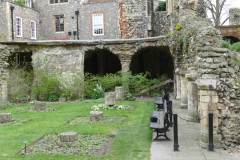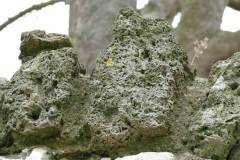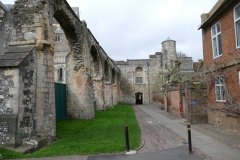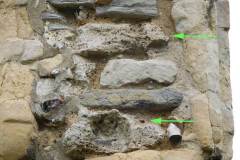Basics
Geology: inorganic carbonate (limestone) precipitate
Rock unit: Tufa – an informal name
Age: Quaternary
Provenance: East Kent
Where to see examples
surviving vaults of the dormitory undercroft (images 1 and 2)
isolated blocks in the wall of the infirmary (images 3 and 4)
Description
The use of tufa as a building stone can be traced back to the ancient Greeks who called the stone poros because of its porous nature. Tufa is formed by the re-deposition of calcium carbonate from ground waters. Rain falling on the North Downs, or on outcrops of the Greensand Ridge, has slowly percolated through the chalk or calcareous sandstone respectively, dissolving carbonate on its way. When the waters re-emerge at the spring-line, they are often saturated with carbonates ready to be precipitated out of solution (much like the process that forms stalactites and stalagmites). The spring location is rich in vegetation and the carbonate is precipitated around the mud and organic matter. Once the vegetation has decayed and the tufa has been left to ‘dry out’ it becomes literally as hard as stone.
The stone is very porous and its colour will depend on the nature and concentration of impurities in the precipitate but is commonly grey-brown after weathering. In its wet state the rock is extremely easy to carve and shape and has the distinct advantage of hardness and durability once it has ‘dried out’.
Tufa deposits were once widespread in Kent but were quickly seized upon by the Norman builders because of their availability and utility. Similar tufaceous deposits were known from Northern France and it has been suggested that some of this stone in the cathedral may have been brought over from the continent. Tufa in a building wall is often seen as an indication of Norman masonry (unless re-used). By the end of the Norman period tufa reserves, it is thought, were all but exhausted in Kent. Much of the tufa used in Canterbury Cathedral may have come from the terraces of the River Stour and therefore derived from the chalk spring waters. The numerous large holes give tufa a characteristic lightness in weight, which make it an ideal building stone where weight restrictions were a consideration. It is rarely an attractive stone as the irregular blocks tend to be roughly cut. It has therefore often provided an essential, but hidden, function in reducing the weight of the stone fabric.
The tufa example in the dormitory undercroft can be found in the wall on the right hand side of the first image. In the ruins of the infirmary examples of tufa can be found in the arches on the left of the overview (image 3).




